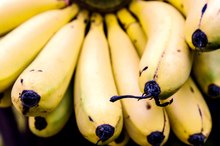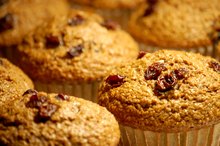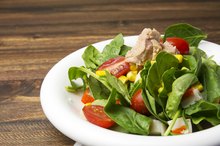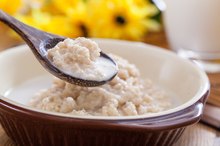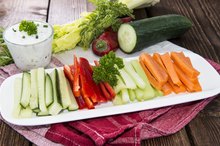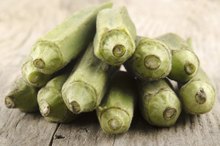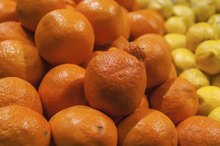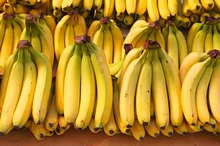What does fact checked mean?
At Healthfully, we strive to deliver objective content that is accurate and up-to-date. Our team periodically reviews articles in order to ensure content quality. The sources cited below consist of evidence from peer-reviewed journals, prominent medical organizations, academic associations, and government data.
The information contained on this site is for informational purposes only, and should not be used as a substitute for the advice of a professional health care provider. Please check with the appropriate physician regarding health questions and concerns. Although we strive to deliver accurate and up-to-date information, no guarantee to that effect is made.
What Vitamins Are in Bananas?
If you are like most Americans, you eat approximately 26 lb. of bananas each year, according to the USDA. Including bananas in your diet provides you with a compact, ready-to-eat source of natural sugars, fiber, potassium, lutein, carotene, choline, water-soluble vitamins and trace amounts of fat-soluble vitamins.
Vitamin B-6
Eating one large banana provides your body with 0.5 mg of vitamin B-6, reports the USDA. If you are younger than age 50, one banana provides roughly 38 percent of the Institute of Medicine's Recommended Dietary Allowance for vitamin B-6.
Vitamin B-6 works with the enzymes in your body to promote metabolic reactions essential for healthy immune system function, protein production and blood sugar maintenance. Your bone marrow uses vitamin B-6 to aid in the production of hemoglobin, the protein within your red blood cells that carries oxygen.
- Eating one large banana provides your body with 0.5 mg of vitamin B-6, reports the USDA.
- Your bone marrow uses vitamin B-6 to aid in the production of hemoglobin, the protein within your red blood cells that carries oxygen.
Vitamin C
Vitamins & Minerals in Potatoes
Learn More
Adding a large banana to your cereal in the morning provides you with approximately 12 mg of vitamin C, according to the USDA. This amount equates to 16 percent of the Institute of Medicine's RDA for vitamin C if you are a woman and 13 percent if you are a man. Vitamin C aids in the production of collagen, found in your skin, cartilage, ligaments and tendons. It also supports your immune system and aids in wound healing.
- Adding a large banana to your cereal in the morning provides you with approximately 12 mg of vitamin C, according to the USDA.
- This amount equates to 16 percent of the Institute of Medicine's RDA for vitamin C if you are a woman and 13 percent if you are a man.
Riboflavin
Including a large banana in your lunch adds approximately 0.1 mg of vitamin B-2, or riboflavin, to your diet. Based on the Institute of Medicine's RDA, one banana provides approximately 8 to 9 percent of your daily riboflavin requirement. Vitamin B-2 helps convert the fats, proteins and carbohydrates in your diet into energy. Riboflavin also aids your liver in detoxifying chemicals and metabolizing drugs, reports the Linus Pauling Institute of Oregon State University 2.
- Including a large banana in your lunch adds approximately 0.1 mg of vitamin B-2, or riboflavin, to your diet.
Folate
The Side Effects of Bananas
Learn More
Bananas provide you with small amounts of vitamin B-9, or folate. One large banana includes approximately 27 micrograms of folate, according to the USDA. This amount equates to roughly 7 percent of the minimum daily requirement if you are an adult man or nonpregnant woman. Folate helps your bone marrow manufacture red blood cells, preventing anemia.
- Bananas provide you with small amounts of vitamin B-9, or folate.
Niacin
One large banana contains approximately 6 percent of the Institute of Medicine's RDA for vitamin B-3, or niacin. Niacin helps your body produce needed fats and acts as a cofactor in the metabolism of proteins, carbohydrates and fats.
Thiamine
Eating one large banana provides you with approximately 3 to 4 percent of the Institute of Medicine's RDA for thiamine, or vitamin B-1. Thiamine proves an essential cofactor in converting the foods you eat into energy. It also helps your body manufacture the genetic material needed to produce new cells, reports the Linus Pauling Institute.
Vitamins A, E and K
The fat-soluble vitamins A, E and K are present in trace amounts in bananas, reports the USDA. Although bananas are a healthy addition to your diet, this fruit provides less than 1 percent of the RDA for vitamins A, E and K. Other food choices in your nutrition plan can provide you with the recommended amounts of these fat-soluble vitamins.
Related Articles
References
- Oregon State University Linus Pauling Institute: Riboflavin
- Bananas, raw. FoodData Central. U.S. Department of Agriculture. Published April 1, 2019.
- Glycemic index for 60+ foods. Harvard Health Publishing, Harvard Medical School. Updated 2020.
- Nutritional Goals for Age-Sex Groups Based on Dietary Reference Intakes and Dietary Guidelines Recommendations. USDA. 2015
- Falcomer AL, Riquette RFR, De lima BR, Ginani VC, Zandonadi RP. Health benefits of green banana consumption: A systematic review. Nutrients. 2019;11(6). doi:10.3390/nu11061222
- Klemm S. Prebiotics and probiotics: Creating a healthier you. Academy of Nutrition and Dietetics. Updated 2020.
- Howarth NC, Saltzman E, Roberts SB. Dietary fiber and weight regulation. Nutr Rev. 2001;59(5):129-39. doi:10.1111/j.1753-4887.2001.tb07001.x
- Pereira A, Maraschin M. Banana (Musa spp) from peel to pulp: ethnopharmacology, source of bioactive compounds and its relevance for human health. J Ethnopharmacol. 2015;160:149-63. doi: 10.1016/j.jep.2014.11.008
- Vitamin C: Fact Sheets for Health Professionals. National Institutes of Health, Office of Dietary Supplements. Updated 2020.
- Hassan AK, Venkatesh YP. An overview of fruit allergy and the causative allergens. Eur Ann Allergy Clin Immunol. 2015;47(6):180-7.
- Manohar M, Verma AK, Upparahalli Venkateshaiah S, Goyal H, Mishra A. Food-induced acute pancreatitis. Dig Dis Sci. 2017;62(12):3287-3297. doi:10.1007/s10620-017-4817-2
Writer Bio
Dr. St. John is a medical writer and editor with more than 15 years experience in the field. She is a former medical officer for the Centers for Disease Control and Prevention.

